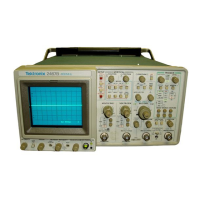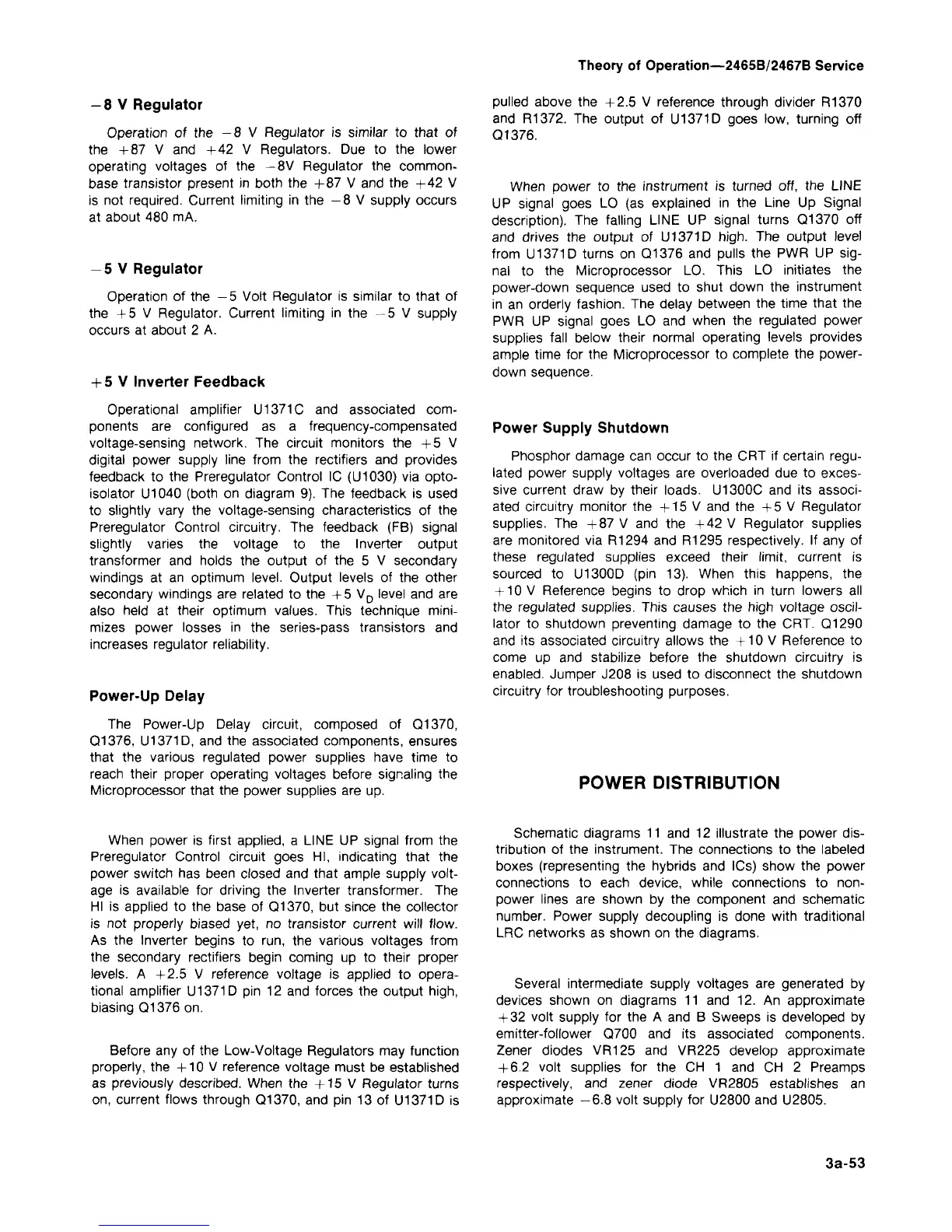Theory of Operation—2465B/2467B Service
-8 V Regulator
Operation of the -8 V Regulator is similar to that of
the +87 V and +42 V Regulators. Due to the lower
operating voltages of the
— 8V
Regulator the common-
base transistor present in both the +87 V and the +42 V
is not required. Current limiting in the -8 V supply occurs
at about 480 mA.
-5 V Regulator
Operation of the -5 Volt Regulator is similar to that of
the +5 V Regulator. Current limiting in the
— 5
V supply
occurs at about 2 A.
+ 5 V Inverter Feedback
Operational amplifier U1371C and associated com-
ponents are configured as a frequency-compensated
voltage-sensing network. The circuit monitors the +5 V
digital power supply line from the rectifiers and provides
feedback to the Preregulator Control IC (U1030) via opto-
isolator U1040 (both on diagram 9). The feedback is used
to slightly vary the voltage-sensing characteristics of the
Preregulator Control circuitry. The feedback (FB) signal
slightly varies the voltage to the Inverter output
transformer and holds the output of the 5 V secondary
windings at an optimum level. Output levels of the other
secondary windings are related to the +5 V
D
level and are
also held at their optimum values. This technique
mini-
mizes power losses in the series-pass transistors and
increases regulator reliability.
Power-Up Delay
The Power-Up Delay circuit, composed of Q1370,
Q1376, U1371D, and the associated components, ensures
that the various regulated power supplies have time to
reach their proper operating voltages before signaling the
Microprocessor that the power supplies are up.
When power is first applied, a LINE UP signal from the
Preregulator Control circuit goes HI, indicating that the
power switch has been closed and that ample supply volt-
age is available for driving the Inverter transformer. The
HI is applied to the base of Q1370, but since the collector
is not properly biased yet, no transistor current will flow.
As the Inverter begins to run, the various voltages from
the secondary rectifiers begin coming up to their proper
levels. A +2.5 V reference voltage is applied to opera-
tional amplifier U1371D pin 12 and forces the output
high,
biasing Q1376 on.
Before any of the Low-Voltage Regulators may function
properly, the +10 V reference voltage must be established
as previously described. When the +15 V Regulator turns
on,
current flows through Q1370, and pin 13 of U1371D is
pulled above the +2.5 V reference through divider R1370
and R1372. The output of U1371D goes low, turning off
Q1376.
When power to the instrument is turned off, the LINE
UP signal goes LO (as explained in the Line Up Signal
description). The falling LINE UP signal turns Q1370 off
and drives the output of U1371D
high.
The output level
from U1371D turns on Q1376 and pulls the PWR UP
sig-
nal to the Microprocessor LO. This LO initiates the
power-down sequence used to shut down the instrument
in an orderly fashion. The delay between the time that the
PWR UP signal goes LO and when the regulated power
supplies fall below their normal operating levels provides
ample time for the Microprocessor to complete the power-
down sequence.
Power Supply Shutdown
Phosphor damage can occur to the CRT if certain
regu-
lated power supply voltages are overloaded due to exces-
sive current draw by their loads. U1300C and its associ-
ated circuitry monitor the +15 V and the +5 V Regulator
supplies. The +87 V and the +42 V Regulator supplies
are monitored via R1294 and R1295 respectively. If any of
these regulated supplies exceed their limit, current is
sourced to U1300D (pin 13). When this happens, the
+ 10 V Reference begins to drop which in turn lowers all
the regulated supplies. This causes the high voltage oscil-
lator to shutdown preventing damage to the CRT. Q1290
and its associated circuitry allows the +10 V Reference to
come up and stabilize before the shutdown circuitry is
enabled.
Jumper J208 is used to disconnect the shutdown
circuitry for troubleshooting purposes.
POWER DISTRIBUTION
Schematic diagrams 11 and 12 illustrate the power dis-
tribution of the instrument. The connections to the labeled
boxes (representing the hybrids and ICs) show the power
connections to each device, while connections to non-
power lines are shown by the component and schematic
number. Power supply decoupling is done with traditional
LRC networks as shown on the diagrams.
Several intermediate supply voltages are generated by
devices shown on diagrams 11 and 12. An approximate
+32 volt supply for the A and B Sweeps is developed by
emitter-follower Q700 and its associated components.
Zener diodes VR125 and VR225 develop approximate
+
6.2
volt supplies for the CH 1 and CH 2 Preamps
respectively, and zener diode VR2805 establishes an
approximate -6.8 volt supply for U2800 and U2805.
3a-53

